NURS 3150 – Foundations of Nursing Research Course Guide & Examples
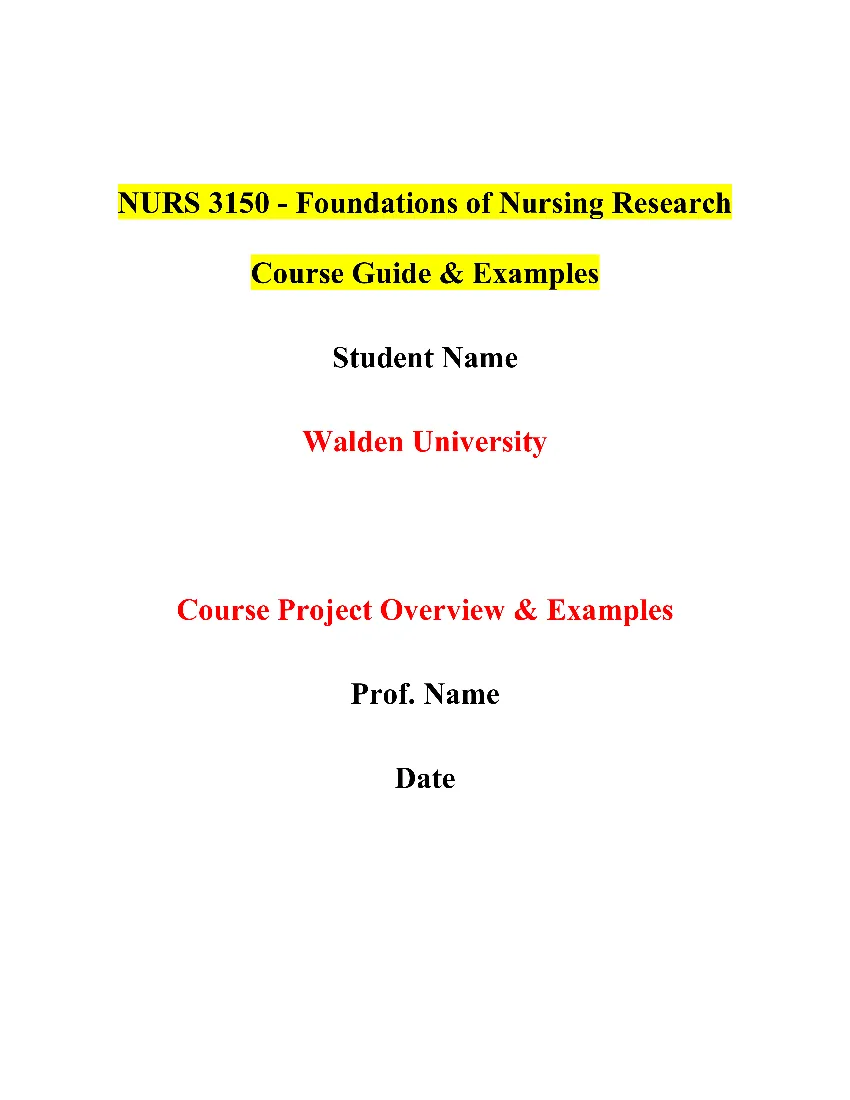 NURS 3150 – Foundations of Nursing Research Course Description
NURS 3150 – Foundations of Nursing Research Course Description
5 credits
Nurses must understand research in order to effectively participate in the provision of evidence-based nursing care. Students in this course learn the foundational elements of the research process, refine information literacy skills, and develop an understanding of ethical research. Students investigate each step of the research process and complete a critical examination of quantitative and qualitative research relevant to their nursing practice. Students are given the tools to analyze nurse-sensitive indicators and clinical practice guidelines.
RN-BSN Track Students Prerequisites
- NURS 3100
- STAT 3001 or PSYC 3002
RN-BSN-AIM Track Students Prerequisites
- NURS 3100
- STAT 3001 or PSYC 3002; cannot be taken with NURS 5052
NURS 3150 – Foundations of Nursing Research Course (5 credits)
- NR3001 Research Process
- Recognize the elements of the research process.
- NR3002 Research Methodology
- Analyze research methodologies.
- NR3003 Interpreting Data
- Analyze and interpret research data.
- NR3004 Research Recommendations
- Generate reasonable conclusions and recommendations based on published research findings.
NURS 3150/3151: Foundations of Nursing Research
Discussion – Week 1
Top of Form
Part 1: Patient Safety Problem
One significant patient safety problem in many healthcare settings is medication errors. Medication errors can occur at any stage of the medication process, including prescribing, transcribing, dispensing, administering, and monitoring. These errors can result from a variety of causes, such as miscommunication among healthcare providers, similar drug names, poor handwriting, lack of patient information, and distractions during the medication administration process. The impact of medication errors on patient outcomes is profound, leading to adverse drug events, increased morbidity and mortality, prolonged hospital stays, and additional healthcare costs (McIntyre, Cover, & Bonner, 2019).
A specific change in practice to address medication errors is the implementation of a comprehensive medication reconciliation process. Medication reconciliation involves verifying the patient’s medication information at each transition of care to ensure consistency and accuracy. This process includes comparing the patient’s current medications with new orders and resolving any discrepancies. Additionally, using electronic health records (EHRs) and computerized physician order entry (CPOE) systems can reduce errors by providing decision support and standardizing medication orders. Education and training of healthcare staff on proper medication administration and the importance of double-checking medications can also play a crucial role in minimizing errors (Gray & Grove, 2021).
Part 2: Research on Patient Safety Problem
To determine the effectiveness of the proposed practice change in improving patient outcomes, the following research question could be developed: “Does the implementation of a comprehensive medication reconciliation process reduce the incidence of medication errors in hospitalized patients?” To answer this research question, a quasi-experimental design would be most appropriate. A quasi-experimental design allows for comparison between groups receiving the intervention (medication reconciliation) and those not receiving it, while not requiring random assignment.
Quasi-experimental designs are advantageous because they are practical and feasible in real-world clinical settings where randomization might not be possible or ethical. They allow for the evaluation of interventions in a naturalistic environment, providing valuable information on the intervention’s effectiveness in routine practice. Additionally, this design can control for confounding variables through statistical methods, enhancing the validity of the findings (Gray & Grove, 2021).
On the other hand, a true experimental design, such as a randomized controlled trial (RCT), might not be suitable for this type of study due to ethical considerations and the difficulty of randomizing patients to different levels of care within a single healthcare setting. Descriptive research, while useful for understanding the scope and nature of medication errors, would not provide information on the causal relationship between the intervention and patient outcomes. Correlational research could identify associations between medication reconciliation and reduced errors but would not establish causality. Qualitative research, although valuable for exploring healthcare providers’ experiences and perceptions, would not quantitatively measure the intervention’s impact on medication error rates (Gray & Grove, 2021).
References
Gray, J. R., & Grove, S. K. (2021). Burns and Grove’s the practice of nursing research: Appraisal, synthesis, and generation of evidence (9th ed.). Elsevier.
McIntyre, M., Cover, D., & Bonner, A. (2019). Nursing-sensitive indicators: A concept analysis. Journal of Nursing Scholarship, 51(4), 399-407.
Responses to Colleagues
Response to Ahmed
Ahmed, your discussion on the importance of a comprehensive medication reconciliation process to reduce medication errors is insightful. The distinction you made between a true experimental design and a quasi-experimental design is crucial in understanding their application in real-world clinical settings. While a true experimental design, like an RCT, offers high internal validity through randomization, the feasibility and ethical considerations often limit its use in healthcare settings (Gray & Grove, 2021). Quasi-experimental designs, although lacking randomization, provide a more practical approach, especially when evaluating interventions already integrated into clinical practice. Your emphasis on the need for practical feasibility in research design is well-founded, considering the dynamic nature of healthcare environments.
Response to Merilyn J. Long
Merilyn, your exploration of the differences between true experimental and quasi-experimental designs in implementing practice changes is very well-articulated. You highlighted key considerations such as time, cost, ethical implications, and sample size, which are essential in selecting an appropriate research design (Gray & Grove, 2021). The practical limitations you mentioned regarding experimental designs in healthcare settings, such as withholding standard care, underscore the ethical dilemmas researchers often face. Your approach to discussing the feasibility and applicability of quasi-experimental designs in real-world clinical settings aligns well with the need for research that can be seamlessly integrated into existing healthcare practices. This perspective is vital for ensuring that research findings are not only valid but also applicable in improving patient outcomes.
Week 1: Overview of Research
What is research, and how does research relate to nursing practice?
Nursing practice is based on outcomes and best practices supported by research findings. That is, issues related to health are examined, and proposed solutions to promote patient safety and health care quality are tested to best determine nursing protocols for professional practice. Consider for example, current nursing protocols to minimize patient falls in health care settings. Without research, extensive testing, and an awareness of how to promote solutions to minimize the risk of falls, there is an increased risk that this very real patient problem would get worse.
This week you explore an overview of the different types of research uses in health care settings. You examine how each type of research is used by nurses in providing quality of care and in promoting positive patient safety outcomes. The week will conclude with an overview of the basic elements of the research process: (a) problem identification, (b) review of literature, (c) implementation of research methods, (d) analyses and presentation of findings, and (e) conclusions about implications for practice. NURS 3150/3151: Foundations of Nursing Research.
Learning Objectives
Students will:
- Describe steps of the research process to advance knowledge about quality of care and patient safety
- Develop a research question that guides the development of a study on patient safety
- Develop a research question that guides the development of a study
- Identify different types of research and their contribution to health care
Learning Resources
Required Readings
Gray, J. R, Grove, S. K., & Sutherland, S. (2017). The practice of nursing research: Appraisal, synthesis, and generation of evidence (8th ed.). St. Louis, MO: Elsevier.
- Chapter 1, “Discovering the World of Nursing Research” (pp. 1-15)
- Chapter 2, “Evolution of Research in Building Evidence-Based Nursing Practice” (pp. 18-34)
- Chapter 5, “Research Problem and Purpose” (pp. 76-93)
- Chapter 6, “Objectives, Questions, Variables, and Hypothesis” (pp. 98-117)
Martinez, K., Battaglia, R., Start, R., Mastal, M.F., & Matlock, A.M. (2015). Nursing sensitive indicators in ambulatory care. Nursing Economics, 33(1), 59-64.
Document: Developing a Good Research Question in Nursing (PDF)
Writing Resources and Program Success Tools
Walden University. (n.d.). Walden templates: General templates: APA course paper template with advice (7th ed.). Retrieved from https://academicguides.waldenu.edu/writingcenter/templates/general
Document: Academic Writing Expectations (AWE) Checklist (Word Document)
This checklist will help you self-assess your writing to see if it meets academic writing standards for this course. NURS 3150/3151: Foundations of Nursing Research.
Discussion: Choosing the Type of Research for a Research Problem
How do you choose the type of research to conduct to address a research problem? What information should you keep in mind to ensure that your research process will adequately address your research problem?
Understanding the different types of research is a critical skill for the nurse researcher and nursing professional. As a current nursing professional, consider how understanding the different types of research may be conducive to achieving a particular mission in your health care setting, such as developing an intervention to address a quality or patient safety problem. This knowledge can also be a step toward assuming a nursing leadership position. As a critical component of your nursing toolkit, differentiating between the types of research is a fundamental step toward enacting change through the process of research.
For this Discussion, please review the following:
- Think about clinical practice problems you have seen in health care that compromise patient safety and health outcomes. For example, nursing-sensitive indicators reflect high-priority practice problems, which are described in the article by Martinez, Battaglia, Start, Mastal, and Matlock (2015).
- Choose one of the clinical practice problems you have seen in your current or past job in a health care setting. Consider the possible causes of this problem and how you think it is, or was, affecting patient outcomes.
- Some patient safety problems are solved by making changes in clinical practice. For example, decreasing catheter-associated urinary tract infections in hospitalized patients often requires changes in clinical practice such as better adherence to preventive measures when catheters are inserted (e.g., use of disposable gloves, maintaining sterile fields, cleansing urethral meatus). For the problem you identified, what specific change in practice do you think is needed?
- When a practice change is implemented, it is important to verify whether or not the change has improved patient outcomes. One way to determine this is by conducting research. One of the first steps in the research process involves developing a research question that will later serve as the foundation for your study. Using information from Chapter 5 in your textbook and the handout on developing research questions, think about a research question and about the effectiveness of the practice change you proposed in improving patient outcomes.
- Another step in the research process involves identifying which type of research could be conducted to best answer your research question. In Chapter 5 of your textbook you will find a list of different types of research in the first column in Table 5-2, and Table 5-3. You can learn more about these different types of research in both Chapter 2 and the Glossary in your textbook. To locate even more information, you can also use an Internet search engine for more in-depth descriptions and examples. After learning more about the different types of research, think about which one you think is best for determining how well the clinical practice change you identified will improve patient outcomes.
By Day 3
Post a description of how you would address the following:
Part 1: Patient Safety Problem
Describe the patient safety problem you identified, its causes, and the impact you think it has on patient outcomes. For this problem, describe a specific change in practice that could help improve patient outcomes.
Part 2: Research on Patient Safety Problem
Develop a research question that tests the effectiveness of your practice change in the improvement of one or more patient outcomes. What type of research would you use to answer this question? Describe the reasons why you think this is the best approach and why you would not use the other three types of research.
Note: Post a three paragraph (at least 350 words) response. Be sure to use evidence, in-text citations, and essay-level writing skills, including the use of transitional material and organizational frames. Use the writing resources to develop your post.
By Day 7
Read two or more of your colleagues’ postings from the Discussion question.
Respond to two or more of your colleagues with a comment that asks for clarification, provides support for, or contributes additional information.
Post a Discussion entry on 3 different days of the week. See the Rubric for more information.
Submission and Grading Information
Grading Criteria
To access your Rubric:
Week 1 Discussion Rubric
Post by Day 3 and Respond by Day 7
To participate in this Discussion:
Week 1 Discussion
Quiz: Nursing Research
By Day 7
Complete the quiz which covers content in the assigned readings for this week. The quiz includes questions that are multiple choice, true/false, and matching.
Note on Quiz Content: This quiz will cover (a) definition and importance of nursing research, (b) nursing research trends in the 21st century, (c) basic steps in the research process, (d) clinical origins of research problems (e.g., nursing sensitive indicators), and (e) feasibility of conducting research in clinical settings. The content is covered in this week’s Learning Resources. NURS 3150 3151: Foundations of Nursing Research.
Submission and Grading Information
Submit Your Quiz by Day 7
To submit your Quiz:
Week 1 Quiz
Week in Review
Now you… know the necessary steps to a research process and developed a research question that guides the development of a study and patient safety, including the impact it has on patient outcomes. Next week you will… conduct a literature review including all the components and demonstrate an understanding of ethical issues in conducting clinical research.
Week 2: Conducting a Literature Search on a Clinical Research Question
Have you ever conducted a literature search before? What does a literature search entail, and why might it be important for nursing practice?
As a nursing professional, you may engage in conducting a literature search in order to refine a clinical research question that you might examine through the research process. Examining, reviewing, and considering the literature in the field will help you to hone your research question and think about new ways you might address or answer a research question with clinical practice.
This week, you examine the skills needed to conduct a literature search to locate other studies that have been conducted on a clinical practice problem. Given the importance of ethical considerations throughout the research process, you will also explore the ethical implications of clinical research. You will examine the definition of research ethics, explore a historical overview of ethical problems in research, consider the ethics of using existing data in research, and the implications of the Health Insurance Portability and Accountability Act (HIPAA) on research. NURS 3150/3151: Foundations of Nursing Research.
Learning Objectives
Students will:
- Perform a literature search on a research topic
- Describe components of a literature review
- Demonstrate an understanding of ethical issues in conducting clinical research
Learning Resources
Required Readings
Gray, J. R, Grove, S. K., & Sutherland, S. (2017). The practice of nursing research: Appraisal, synthesis, and generation of evidence (8th ed.). St. Louis, MO: Elsevier.
- Chapter 7, “Review of Relevant Literature” (pp. 120-136)
- Chapter 9, “Ethics in Research” (pp. 157-188)
Purdue Online Writing Lab. (2015). Retrieved from https://owl.english.purdue.edu/owl/resource/560/07/
Walden University Library. (2015b). Keyword searching: Finding articles on your topic: Searching basics. Retrieved from http://academicguides.waldenu.edu/library/keyword
Walden University Library. (2015a). How do I find databases by subject? Retrieved from http://academicanswers.waldenu.edu/faq/73256
Walden University Library. (2015c). Searching and finding information in the library databases: Overview. Retrieved from http://academicguides.waldenu.edu/searchingfinding
Writing Resources and Program Success Tools
Walden University. (n.d.). Walden templates: General templates: APA course paper template with advice (7th ed.). Retrieved from https://academicguides.waldenu.edu/writingcenter/templates/general
Document: Academic Writing Expectations (AWE) Checklist (Word Document)
This checklist will help you self-assess your writing to see if it meets academic writing standards for this course.
Required Media
Walden University Library. (2019, June). Introduction to nursing research in the Walden Library [Webinar]. Retrieved from https://academicguides.waldenu.edu/nurs3150/week2discussion
Discussion: Conducting a Literature Review
For this Discussion, view the webinar in this week’s resources by a Walden University librarian on strategies to conduct a successful literature search. The webinar provides information on available databases, the use of search engines, and the selection of search terms. Then, you will conduct a literature search on research conducted in the last 5 years on the patient safety problem you identified in Week 1. NURS 3150/3151: Foundations of Nursing Research
By Day 3
Post the following:
For the literature search, describe the following in your post:
- The databases, search engines, and search terms you used in your literature search
- The number of research articles you found on your patient safety problem that were published in the last year
- The challenges you encountered locating research articles and how you overcame them
- Who you would go to for help in your work setting if you needed help with a literature search
Note: Post a three paragraph (at least 350 words) response. Be sure to use evidence, in-text citations, and essay-level writing skills, including the use of transitional material and organizational frames. Use the writing resources to develop your post.
By Day 7
Read two or more of your colleagues’ postings from the Discussion question.
Respond to two or more of your colleagues with a comment that asks for clarification, provides support for, or contributes additional information.
Post a Discussion entry on 3 different days of the week. See the Discussion Rubrics for more information.
Submission and Grading Information
Grading Criteria
To access your Rubric:
Week 2 Discussion Rubric
Post by Day 3 and Respond by Day 7
To participate in this Discussion:
Week 2 Discussion
Quiz: Ethical Implications of Research
By Day 7
Complete the quiz which covers content in the assigned readings for this week. The quiz questions are multiple choice.
Note on Quiz Content: This quiz will cover (a) ethics in research, (b) human rights in research, and (c) clinical research. The content is covered in this week’s Learning Resources.
Submission and Grading Information
Submit Your Quiz by Day 7
To submit your Quiz:
Week 2 Quiz
Week in Review
Now you… have conducted a literature review that includes a number of research articles, shared the challenges encountered in locating them and ways to overcome them. Next week you will… be introduced to quantitative research designs and the strengths and weaknesses of those methods.
Week 3: Quantitative Research Designs and Methods
Andre is a nursing student who has just completed the first 2 weeks in a nursing research course. He has defined a clinical research question for his health care setting and has also determined that the research problem exists in the literature. However, his approach to defining a solution for his research question requires that he receive approval from his health care setting before testing it. However, Andre is not quite sure what he needs to do next. Eager to start, Andre jumps ahead in the course syllabus and sees that in the following weeks he will read about quantitative research design and methods. Slightly confused, he is not quite sure what is meant by quantitative research design and methods and begins drafting an email message to his instructor to see if he might be able to use this information for testing
his research question in practice. NURS 3150/3151: Foundations of Nursing Research
What is quantitative research design? What different methods might exist for engaging in quantitative research for nursing practice?
As you have explored in this course, your next step in the research process is to determine what type of research design and methods you will use to engage in research for your research question. While it is possible that many research designs and methods might be appropriate for your particular research question, gaining a firm understanding of different research designs and methods is another useful skill for engaging in nursing research and practice.
This week, you explore the different categories of quantitative research designs used in a clinical research studies. These include experimental, quasi-experimental, descriptive and correlational designs. You will examine the basic characteristics of each design (e.g., causality, control, bias, validity, randomization, probability). You will also examine the basic features of the methods used to conduct most quantitative research designs, such as sample selection, data collection and measurement of variables, as well as data management and analyses.
Learning Objectives
Students will:
- Demonstrate an understanding of the basic characteristics of quantitative research designs
- Analyze the strengths and weaknesses of methods used in quantitative research designs
Learning Resources
Note: To access this week’s required library resources, please click on the link to the Course Readings List, found in the Course Materials section of your Syllabus.
Required Readings
Gray, J. R, Grove, S. K., & Sutherland, S. (2017). The practice of nursing research: Appraisal, synthesis, and generation of evidence (8th ed.). St. Louis, MO: Elsevier.
- Chapter 3, “Introduction to Quantitative Research” (pp. 37-58)
- Chapter 10, “Quantitative Methodology: Noninterventional Designs and Methods” (pp. 192-215)
- Chapter 11, “Quantitative Methodology: Interventional Designs and Methods” (pp. 217-248)
- Chapter 15, “Sampling” (pp. 329-360)
Labrague, L. & McEnroe-Petitte, D. (2016). Influence of music on preoperative anxiety and physiological parameters in women undergoing gynecologic surgery. Clinical Nursing Research, 25(2), 157-173.
Sand-Jecklin, K., & Sherman, J. (2014). A quantitative assessment of patient and nursing outcomes of bedside nursing report implementation. Journal of Clinical Nursing, 23(19/20), 2854–2863.
Steelman, V. M., Graling, P. R., & Perkhounkova, Y. (2013). Priority patient safety issues identified by perioperative nurses. AORN Journal, 97(4), 402–418.
Document: Journal Club Template for Quantitative Research (Word Document)
Writing Resources and Program Success Tools
Walden University. (n.d.). Walden templates: General templates: APA course paper template with advice (7th ed.). Retrieved from https://academicguides.waldenu.edu/writingcenter/templates/general
Document: Academic Writing Expectations (AWE) Checklist (Word Document)
This checklist will help you self-assess your writing to see if it meets academic writing standards for this course.
Required Media
Laureate Education (Producer). (2015c). Quantitative research designs [Video file]. Baltimore, MD: Author.
Note: The approximate length of this media piece is 27 minutes.
Optional Resources
Fitzpatrick, J. J. (Ed.). (2017). Encyclopedia of nursing research (4th ed.). New York, NY: Springer.
Grove, S. K., & Gray, J. R. (2018). Understanding nursing research: Building an evidence-based practice (7th ed.) (pp. 214–263). St. Louis, MO: Elsevier.
Discussion: Reliability and Validity of Research Methodology
Selection of the appropriate sample is critical to the reliability and validity of research methodology. The sample must be representative of the population that is being studied. Researchers often report both the inclusion and exclusion criteria for the sample. There are many different methods for selecting a sample and random sampling provides the high control of outside variables but is often difficult to utilize in many studies.
For this Discussion, please review the following:
- For this assignment, read the article by Labrague, L. & McEnroe-Petitte, D. (2016). Influence of music on preoperative anxiety and physiological parameters in women undergoing gynecologic surgery. Clinical Nursing Research, 25(2), 157-173, listed in the resource section for this week.
By Day 3
Prepare at least a 350-word post discussing the strengths and weaknesses of the sampling method used in this study and if the sampling method promoted reliable and valid results. Include in the discussion if there is anything the researcher could have done to improve the sampling process.
Note: Post a three paragraph (at least 350 words) response. Be sure to use evidence from the readings and include in-text citations. Utilize essay-level writing practice and skills, including the use of transitional material and organizational frames. Use the writing resources to develop your post.
By Day 7
Read two or more of your colleagues’ postings from the Discussion question.
Respond to two or more of your colleagues with a comment that asks for clarification, provides support for, or contributes additional information.
Post a Discussion entry on 3 different days of the week. See the Discussion Rubrics for more information.
Submission and Grading Information
Grading Criteria
To access your Rubric:
Week 3 Discussion Rubric
Post by Day 3 and Respond by Day 7
To participate in this Discussion:
Week 3 Discussion
Quiz: Basic Characteristics of Quantitative Research Designs
By Day 7
Complete the quiz which covers the content in the Quantitative Research Design PowerPoint webinar and assigned readings for this week. The quiz includes questions that are multiple choice, true/false, and matching. Be sure to familiarize yourself with the following five characteristics of quantitative research designs: (a) causality, (b) control, (c) randomization, (d) reliability, and (e) validity.
Note on Quiz Content: This quiz will cover: (a) four basic quantitative designs along with their overall strengths and weaknesses, (b) characteristics of quantitative research designs, (c) problems with the commonly pretest-posttest study [one type of quasi-experimental design], and (d) value of randomized clinical trials in health care.
Submission and Grading Information
Submit Your Quiz by Day 7
To submit your Quiz:
Week 3 Quiz
Assignment: Application: Methods Used in Quantitative Research
As you have explored this week, there are various methods a researcher may use to engage in quantitative research design. While the methods presented this week are not exhaustive, they do introduce numerous features that you will likely encounter when reviewing, accessing, and researching the nursing practice literature. Whether you are creating new research or searching the literature to add support for a research question you are interested in, understanding the quantitative research designs that may be used for nursing practice will likely inform how you will conduct research for your health care setting. As you continue to build upon your research skills as a nursing researcher and professional, understanding how to engage in quantitative research design is a valuable asset.
For this Assignment, view this week’s Quantitative Research Designs PowerPoint webinar and pay close attention to its content on the basic elements of research methods (e.g., sample, data collection, measurement, analysis). Then, be sure to review the research study by Sand-Jekline and Sherman (2014), included in this week’s resources.
Note: While not a required resource, you might find the definitions in the Encyclopedia of Nursing Research helpful for this assignment.
This assignment involves identifying and describing the strengths and weaknesses of the research method used in the Sand-Jecklin and Sherman (2014) research article in this week’s resources.
- Focus on the research design, sample data collection methods, tools used for data collection, and the plan for data analysis as discussed in the Sand-Jecklin and Sherman (2014) article.
- Identify at least two strengths and two weaknesses of the study based on reliability and validity by including additional support with citations from resources not assigned this week.
- Use the copy of the Journal Club Template for Quantitative Research located in this week’s resources. The template includes an area for each element discussed in the study.
- Be brief, paraphrase and summarize each of the elements clearly on the form.
- Provide the full citation of the article used for this Assignment on the template.
By Day 7
Once this is complete, save your file and submit the Journal Club Template for Quantitative Research to the submission link.
Submission and Grading Information
To submit your completed Assignment for review and grading, do the following:
- Please save your Assignment using the naming convention “WK3Assgn+last name+first initial.(extension)” as the name.
- Click the Week 3 Assignment Rubric to review the Grading Criteria for the Assignment.
- Click the Week 3 Assignment link. You will also be able to “View Rubric” for grading criteria from this area.
- Next, from the Attach File area, click on the Browse My Computer button. Find the document you saved as “WK3Assgn+last name+first initial.(extension)” and click Open.
- If applicable: From the Plagiarism Tools area, click the checkbox for I agree to submit my paper(s) to the Global Reference Database.
- Click on the Submit button to complete your submission.
Grading Criteria
To access your Rubric:
Week 3 Assignment Rubric
Check your Assignment draft for authenticity
To check your assignment draft for authenticity
Submit your Week 3 Assignment Draft, and review the “SafeAssign Originality Report”
Submit Your Assignment by Day 7
To submit your Assignment:
Week 3 Assignment
Week in Review
Now you have examined the basic characteristics of quantitative research designs used in nursing for clinical research questions including causality, control, randomization, reliability and validity. Next week you will….analyze the elements, strengths, and weaknesses of methods used in qualitative research designs and examine the differences between quantitative/qualitative research designs.
To go to the next week:
Week 4
Week 4: Qualitative Research Designs and Methods
[Qualitative research] is more than simply conducting research on a single individual or situation. This approach has the potential to deal with simple through complex situations. It enables the researcher to answer “how” and “why” type questions, while taking into consideration how a phenomenon is influenced by
the context within which it is situated.
– Pamela Baxter and Susan Jack,
“Qualitative Case Study Methodology”
How does qualitative research differ from quantitative research? How might a research question best be answered by using a qualitative research design approach?
Last week, you explored different quantitative research designs used in nursing research for clinical research questions. While quantitative research designs are appropriate and useful for a wide range of research questions, you might find that adopting a qualitative approach may yield different insights that might best support solutions for a given research question. Understanding the differences between quantitative/qualitative research designs, and their methods, will contribute to effective nursing practice and your role as a nursing professional.
This week, you examine qualitative research designs and methods. You will first explore the different types of qualitative research approaches used in clinical research studies, including obtrusive (e.g., participatory action, ethnography), unobtrusive (e.g., non-participatory observation, audiovisual), and observational (e.g., focus groups, in-depth interviews). Then, you examine the basic characteristics of each approach (e.g., inductive reasoning, narrative descriptions, process orientation), as well as the characteristics of different approaches used to conduct qualitative research designs, such as sample selection, data collection, data management, and interpretative techniques.
Learning Objectives
Students will:
- Analyze the strengths and weaknesses of methods used in qualitative research designs
- Analyze elements of qualitative research designs
Learning Resources
Required Readings
Gray, J. R, Grove, S. K., & Sutherland, S. (2017). The practice of nursing research: Appraisal, synthesis, and generation of evidence (8th ed.). St. Louis, MO: Elsevier.
- Chapter 4, “Introduction to Qualitative Research” (pp. 62-73)
- Chapter 12, “Qualitative Research Methods” (pp. 251-281)
Bamm, E. L., Rosenbaum, P., Wilkins, S., Stratford, P., & Mahlberg, N. (2015). Exploring client-centered care experiences in in-patient rehabilitation settings. Global Qualitative Nursing Research, 2, 1–11.
Sarvestani, R. S., Moattari, M., Nasrabadi, A. N., Momennasab, M., & Yektatalab, S. (2015). Challenges of nursing handover: A qualitative study. Clinical Nursing Research, 24(3), 234–252.
Stiffler, D., Cullen, D. & Luna, G. (2014). Diabetes barriers and self-care management: The patient perspective. Clinical Nursing Research, 23(6), 601-626.
Walsh, A., Meagher-Stewart, D. & Macdonald, M. (2015). Persistent optimizing: How mothers make food choices for their preschool children. Qualitative Health Research, 25(4), 527-539.
Document: Journal Club Template for Qualitative Research (Word Document)
Writing Resources and Program Success Tools
Walden University. (n.d.). Walden templates: General templates: APA course paper template with advice (7th ed.). Retrieved from https://academicguides.waldenu.edu/writingcenter/templates/general
Document: Academic Writing Expectations (AWE) Checklist (Word Document)
This checklist will help you self-assess your writing to see if it meets academic writing standards for this course.
Required Media
Laureate Education (Producer). (2015b). Qualitative research design [Video file]. Baltimore, MD: Author.
Note: The approximate length of this media piece is 11 minutes.
Discussion: Basic Characteristics of Qualitative Research
As a nursing professional, you will likely engage in research for your health care setting. Depending on the research question you seek to address, you might choose to use a qualitative research design. Understanding when and why it is appropriate to choose a qualitative research design will be important as you develop research skills for nursing practice. As you continue throughout this course, think about what considerations you should keep in mind when choosing to engage in qualitative research. In what ways might qualitative research be more preferred than quantitative research for informing nursing practice?
For this Discussion, be sure to review the qualitative article by Sarvestani et al. (2015). Then, view this week’s Qualitative Research Design PowerPoint webinar that describes each step of the qualitative research process and different approaches used to conduct qualitative research.
By Day 3
You will need to prepare and post a 350-word response that addresses the following:
- Qualitative research often is viewed as not having the same rigor and adherence to objective standards as quantitative studies. Using the references provided to assist you, prepare an argument to either support or refute this claim and post it to the Discussion. In your response, explain if qualitative research does or does not have the controls needed to generate the results that contribute to the nursing knowledge base.
- Then, explain if qualitative research could be used to investigate the patient safety problem you identified in Week 1.
Note:Post a three paragraph (at least 350 words) response. Be sure to use evidence from the readings and include in-text citations. Utilize essay-level writing practice and skills, including the use of transitional material and organizational frames. Use the writing resources to develop your post. NURS 3150/3151: Foundations of Nursing Research
Evidence
In-text Citations
Essay-Level
Transitional Material
Organizational Frames
By Day 7
Read two or more of your colleagues’ postings from the Discussion question.
Respond to two or more of your colleagues with a comment that asks for clarification, provides support for, or contributes additional information.
Post a Discussion entry on 3 different days of the week. See the Discussion Rubrics for more information.
Submission and Grading Information
Grading Criteria
To access your Rubric:
Week 4 Discussion Rubric
Post by Day 3 and Respond by Day 7
To participate in this Discussion:
Week 4 Discussion
Assignment: Application: Methods Used in Qualitative Research
In order to achieve credible and trustworthy results from qualitative studies, the methodology must be designed very carefully. That is, you must consider the process of conducting qualitative research to address your research question. Important considerations include selecting the research question, collecting data, engaging in data analysis and management, and selecting appropriate
interpretive techniques.
For this Assignment, be sure to view this week’s Qualitative Research Design PowerPoint webinar and pay close attention to its content on the basic elements of qualitative research methods (e.g., sample selection, data collection, plans for interpretive analysis). Then, review the two research studies presented in this week’s resources for this assignment.
Note: While not a required resource, you might find the definitions in the Encyclopedia of Nursing Research helpful for this assignment.
This assignment involves identifying and describing different elements of the research method used in the Walsh et al. (2015) article.
- Focus on the research design, sample selection, data collection methods, and plan for data analysis as discussed in the Walsh et al. (2015) article.
- Identify at least two strengths and two weaknesses of the article’s research method based on trustworthiness. You must provide support for your explanation with citations from additional sources.
- Use the Journal Club Template for Qualitative Research located in this week’s resources.
- The template includes an area for each element discussed in the study.
- Be brief, paraphrase and summarize each of the elements clearly on the form
By Day 7
Once this is complete, save your file and submit the Journal Club Template for Qualitative Research to the submission link.
Submission and Grading Information
To submit your completed Assignment for review and grading, do the following:
- Please save your Assignment using the naming convention “WK4Assgn+last name+first initial.(extension)” as the name.
- Click the Week 4 Assignment Rubric to review the Grading Criteria for the Assignment.
- Click the Week 4 Assignment link. You will also be able to “View Rubric” for grading criteria from this area.
- Next, from the Attach File area, click on the Browse My Computer button. Find the document you saved as “WK4Assgn+last name+first initial.(extension)” and click Open.
- If applicable: From the Plagiarism Tools area, click the checkbox for I agree to submit my paper(s) to the Global Reference Database.
- Click on the Submit button to complete your submission.
Grading Criteria
To access your Rubric:
Week 4 Assignment Rubric
Check your Assignment draft for authenticity
To check your assignment draft for authenticity
Submit your Week 4 Assignment 1 Draft, and review the “SafeAssign Originality Report”
Submit Your Assignment by Day 7
To submit your Assignment:
Week 4 Assignment 1
Week in Review
Now you…..have analyzed the basic characteristics of qualitative research and discovered the differences between qualitative and quantitative studies. You have also examined if qualitative research has the controls needed to generate results that contribute to the nursing knowledge base. Next week you will….examine the analysis of data with a focus on common statistical techniques that include descriptive and comparative analyses.
Week 5: Analysis of Quantitative and Qualitative Data
Jaime has just completed gathering quantitative and qualitative data on causes of hospital acquired infections (HAIs) on a medical/surgical unit in his hospital. After collecting data on different patients, physicians, procedures, and infections, Jaime is ready to begin analyzing the data. However, how should Jaime proceed? What data is most telling for indicating to the hospital that the medical/surgical unit is experiencing an unexpected increase in the rate of HAIs? How will Jaime determine what type of analyses will be most important for articulating his research question and proposed nursing practice solutions? NURS 3150 3151: Foundations of Nursing Research
Once you have collected and gathered data, the next step in the research process is to engage in the analysis of the data. Whether you perform statistical tests to determine if your data is significant or pool responses to interview questions to indicate emerging themes and patterns, understanding the types of analysis available for the research process is important in order to draw necessary conclusions to inform nursing practice. As a nursing professional, if you engage in research for your health care setting, you will likely engage in the analysis of your data to help inform, implement, and evaluate nursing practice solutions.
This week, you examine the analysis of data, including a focus on common statistical techniques: (a) descriptive analyses (e.g., frequency distributions and mean scores with standard deviations) and (b) comparative analyses (e.g., t-test, chi square). You will also consider the importance of using existing quantitative health care data to address clinical questions in nursing practice, including electronic medical records and local, regional, and national quality and safety databases. For qualitative research, you will explore an overview on the common techniques used to understand themes and patterns in narrative data.
Learning Objectives
Students will:
- Identify available local, regional, and national quantitative databases on health care issues
- Analyze nursing quality indicators in relation to patient safety
- Conduct descriptive analyses of quantitative and qualitative data
Learning Resources
Required Readings
Gray, J. R, Grove, S. K., & Sutherland, S. (2017). The practice of nursing research: Appraisal, synthesis, and generation of evidence (8th ed.). St. Louis, MO: Elsevier.
- Chapter 21, “Introduction to Statistical Analysis” (pp. 519-533)
- Chapter 22, “Using Statistics to Describe Variables” (pp. 535-544)
- Chapter 12, “Qualitative Research Methodology”
- “Qualitative Data Analysis” (pp. 268-270)
Medicare.gov. (n.d.-a). Hospital compare. Retrieved December 16, 2015, from https://www.medicare.gov/hospitalcompare/About/What-Is-HOS.html
Medicare.gov. (n.d.-b). Home health compare. Retrieved December 16, 2015, from https://www.medicare.gov/homehealthcompare/
Medicare.gov. (n.d.-c). Nursing home compare. Retrieved from https://www.medicare.gov/nursinghomecompare/search.html
Quantitative Resources
Document: Instructions: Quantitative Analysis Assignment (PDF)
Document: Codebook: Quantitative Patient Safety Data (PDF)
Document: Summary Data Analysis Form (Word document)
Document: Quantitative Data Excel Assignment (Excel spreadsheet)
Qualitative Resources
Document: Instructions: Content Coding of Student Pet Peeves (Word document)
Document: Perceived Pet Peeves Data (PDF)
Document: Code Sheet: Student Pet Peeve Data (Word Document)
Writing Resources and Program Success Tools
Walden University. (n.d.). Walden templates: General templates: APA course paper template with advice (7th ed.). Retrieved from https://academicguides.waldenu.edu/writingcenter/templates/general
Document: Academic Writing Expectations (AWE) Checklist (Word Document)
This checklist will help you self-assess your writing to see if it meets academic writing standards for this course.
Discussion: Access to Existing Databases on Patient Safety, Quality of Care, and Clinical Practice
Quantitative health care databases are developed and published to give health care providers and consumers information about patient quality and safety outcomes. These reports are often distributed to staff in patient care units and shared with health agencies. Understanding the variables and findings described in
these databases is important.
By Day 3
Post a description of one existing source of data you found with variables related to a patient quality and safety problem in your practice. Locate the data posted for your agency/facility. If you are unable to find this information for your agency, locate a national database that can be accessed by health professionals, e.g., Medicare Hospital Compare. (Data are also available for home health and nursing homes.) Include the citation and the link to use for web access. Identify three variables found in the database that are important in better understanding a patient safety problem. Explain how you would interpret the results and how they might help improve nursing practice and patient outcomes. Explain how data is used in your own agency, including nursing involvement in the process.
Medicare Hospital Compare
Note:Post a three paragraph (at least 350 words) response. Be sure to use evidence from the readings and include in-text citations. Utilize essay-level writing practice and skills, including the use of transitional material and organizational frames. Use the writing resources to develop your post.
Evidence
In-text Citations
Essay-Level
Transitional Material
Organizational Frames
By Day 7
Read two or more of your colleagues’ postings from the Discussion question.
Respond to two or more of your colleagues with a comment that asks for clarification, provides support for, or contributes additional information.
Post a Discussion entry on 3 different days of the week. See the Discussion Rubrics for more information.
Submission and Grading Information
Grading Criteria
To access your Rubric:
Week 5 Discussion Rubric
Post by Day 3 and Respond by Day 7
To participate in this Discussion:
Week 5 Discussion
Assignment: Application: Analysis of Quantitative and Qualitative Data
In order to provide meaningful results, research processes must be carefully selected and appropriate for the data being analyzed. Statistical programs such as SPSS are frequently utilized by researchers to conduct the analysis of large data sets. These data are organized to provide meaningful interpretation and often include descriptive statistics. Qualitative analysis is completed using content analysis, looking for patterns and themes that emerge from the data. Individual experiences described in interviews and focus groups are considered data and are often provided as examples to support the results in the study publication. Whether you will engage in either quantitative or qualitative research, it is likely that you will encounter both types of studies in the literature. As a nursing professional, being able to analyze and interpret both types of research designs will be important to affect nursing practice that promotes positive health outcomes in
quality of care and patient safety. NURS 3150 3151: Foundations of Nursing Research
For Part 1 of this Assignment, you will conduct descriptive statistical analyses using quantitative data. For Part 2 of this Assignment, you will conduct content coding to analyze qualitative data. Please review the Instructions: Quantitative Analysis Assignment and Instructions: Content Coding of Student Pet Peeves in this week’s resources to review how to complete both parts of this Assignment.
Part 1: Quantitative Analyses
- Follow the step-by-step instructions provided in the Instructions: Quantitative Analysis Assignment document in this week’s resources on using the Excel program to conduct descriptive analyses of quantitative data.
- The Quantitative Data Excel Assignment spreadsheet that you will need is in the resources for this week.
- For this Assignment, you will need to describe the findings from your analyses and summarize what they tell you about these patients and the extent of the adverse events they experienced during their hospitalization by completing the Summary Data Analysis Form in this week’s resources.
Part 2: Qualitative Analyses
- Follow the step-by-step instructions provided in the Instructions: Content Coding of Student Pet Peeves document in this week’s resources. The document provides detailed instructions on the step-by-step process of conducting the content analysis for this part of the Assignment.
- Access the Perceived Pet Peeves Data document located in this week’s resources that includes the narrative descriptions of 10 students about their “pet peeves’ in courses they have taken. (In other words, what are the things that detracted from their learning experiences in these courses)?
- The analytic method you will use to analyze the narrative data for this Assignment is called content analysis. It requires you to read each student’s narrative and then code its content using thematic categories on a coding sheet.
- Access the Code Sheet: Student Pet Peeve Data document located in this week’s resources to carry out the coding as defined in the instructions.
- For the written part of this assignment, you will need to describe the most common types of “pet peeves” that students have about their courses.
By Day 7
Submit both your Part I: Quantitative Analysis and Part II: Qualitative Analysis components.
Submission and Grading Information
To submit your completed Assignment 1 for review and grading, do the following:
- Please save your Assignment using the naming convention “WK5Assgn1+last name+first initial.(extension)” as the name.
- Click the Week 5 Assignment Part 1 Rubric to review the Grading Criteria for the Assignment.
- Click the Week 5 Assignment Part 1 link. You will also be able to “View Rubric” for grading criteria from this area.
- Next, from the Attach File area, click on the Browse My Computer button. Find the document you saved as “WK5Assgn1+last name+first initial.(extension)” and click Open.
- If applicable: From the Plagiarism Tools area, click the checkbox for I agree to submit my paper(s) to the Global Reference Database.
- Click on the Submit button to complete your submission.
Grading Criteria
To access your Rubric:
Week 5 Assignment 1 Rubric
Check your Assignment draft for authenticity
To check your assignment draft for authenticity
Submit your Week 5 Assignment 1 Draft, and review the “SafeAssign Originality Report”
Submit Your Assignment by Day 7
To submit your Assignment:
Week 5 Assignment 1
To submit your completed Assignment 2 for review and grading, do the following:
- Please save your Assignment using the naming convention “WK5Assgn2+last name+first initial.(extension)” as the name.
- Click the Week 5 Assignment Part 2 Rubric to review the Grading Criteria for the Assignment.
- Click the Week 5 Assignment Part 2 link. You will also be able to “View Rubric” for grading criteria from this area.
- Next, from the Attach File area, click on the Browse My Computer button. Find the document you saved as “WK5Assgn2+last name+first initial.(extension)” and click Open.
- If applicable: From the Plagiarism Tools area, click the checkbox for I agree to submit my paper(s) to the Global Reference Database.
- Click on the Submit button to complete your submission.
Grading Criteria
To access your Rubric:
Week 5 Assignment 2 Rubric
Check your Assignment draft for authenticity
To check your assignment draft for authenticity
Submit your Week 5 Assignment 2 Draft, and review the “SafeAssign Originality Report”
Submit Your Assignment by Day 7
To submit your Assignment:
Week 5 Assignment 2
Week in Review
Now you…..have examined the analysis of data and the importance of using existing quantitative health care data to address clinical questions in nursing practice, and qualitative research techniques to understand themes and patterns in narrative data. Next week you will….tie it all together by examining two content areas; drawing conclusions about research findings and their implications for clinical practice and the value of research in evidence-based practice and translational science.
Week 6: Tying it All Together
Once a nursing researcher or nursing professional has conducted analyses on their collected data, what can they conclude about their research and research question?
The last and final phase of the research process involves drawing conclusions about research findings as well as tying them into meaningful solutions for clinical nursing practice. How might a nursing researcher or nursing professional relate their research findings to solutions for improved quality of care and patient safety? How might drawing certain conclusions from research findings impact your health care setting?
This week, you will examine two content areas.
Part I: Drawing Conclusions About Research Findings and Their Implications for Clinical Practice
Part I focuses on the last phase of the research process, namely drawing conclusions about the findings and discussing their implications for clinical practice. You will examine how the findings contribute to clinical practice and how the findings might add to new knowledge and the existing literature on a topic. You will consider how the characteristics of well-written conclusions and implications, including consideration of the study’s limitations, recommendations for future research, and variation in the quality of presenting these areas in published research may impact nursing practice. NURS 3150 3151: Foundations of Nursing Research
Part II: The Value of Research in Evidence-Based Practice and Translational Science
Part II focuses on what has been explored about the value of quantitative and qualitative research in evidence-based practice and translational science in nursing.
Learning Objectives
Students will:
- Evaluate how evidence-based practice will improve patient quality and safety
- Evaluate the importance of the interpretation, conclusion, and clinical implications of clinical research articles in evidence-based practice
- Evaluate effectiveness of interventions on decreasing medication errors in health care settings
Learning Resources
Required Readings
Gray, J. R, Grove, S. K., & Sutherland, S. (2017). The practice of nursing research: Appraisal, synthesis, and generation of evidence (8th ed.). St. Louis, MO: Elsevier.
- Chapter 26, “Interpreting Research Outcomes” (pp. 578–591)
Becker, P. T. (2009). Thoughts on the end of the article: The implications for nursing practice. Research in Nursing & Health, 32(3), 241–242.
Thoughts on the end of the article: The implications for nursing practice by Becker, P. T., in Research in Nursing & Health, 32(3), 241–242. Copyright by John Willey & Sons – Journals. Reprinted by permission of John Willey & Sons – Journals via the Copyright Clearance Center.
Titler, M. G. (2008). Chapter 7. The evidence for evidence-based practice implementation. In R.G. Hughes (Ed.), Patient safety and quality: An evidence-based handbook for nurses (Vol. 1, 113–116). Rockville, MD: Agency for Healthcare Research and Quality.
Agency for Healthcare Research and Quality, U.S. Department of Health and Human Services. (2008, April). Patient Safety and Quality: An Evidence-Based Handbook for Nurses, Volume 1. Retrieved from http://archive.ahrq.gov/professionals/clinicians-providers/resources/nursing/resources/nurseshdbk/nurseshdbk.pdf
Document: Writing Conclusions to Nursing Studies (PDF)
Document: Research Methods and Findings of the 2014 Verweij Study (PDF)
Writing Resources and Program Success Tools
Document: Week 6 Paper Template (Word Document)
Document: Academic Writing Expectations (AWE) Checklist (Word Document)
This checklist will help you self-assess your writing to see if it meets academic writing standards for this course.
Discussion: Use of Research in Clinical Practice
Throughout this course, you have examined and considered how the research process contributes to the field of clinical nursing practice. More than just an exercise in developing a research question, searching the literature to guide future research, and performing actual data collection/data analysis, the conclusions you draw from your research findings are useful in helping to develop and enact effective clinical practice. In essence, the process of conducting research contributes to positive social change in that the solutions that you might propose as a nurse researcher and professional will likely impact quality of care and patient safety.
For this Discussion, read the book chapter by Titler (2008) presented in this week’s resources that describes evidence-based practice and translational science, as well as the kind of research needed for both. Then, reflect on how the knowledge you gained about research will support your effort as a nursing professional to improve patient quality and safety.
By Day 3
Describe how you will use evidence-based practice to improve patient quality and safety in your health care setting. Be specific and provide examples. Then, explain how the knowledge gained about research in this course will support your role in practice as a nursing professional. Then, describe how you will use evidence-based practice to improve patient quality and safety. Be sure to include in your Discussion any unanswered questions that need to be considered by your classmates and/or Instructor.
Note: Post a three paragraph (at least 350 words) response. Be sure to use evidence from the readings and include in-text citations. Utilize essay-level writing practice and skills, including the use of transitional material and organizational frames. Use the writing resources to develop your post.
Evidence
In-text Citations
Essay-Level
Transitional Material
Organizational Frames
By Day 7
Read two or more of your colleagues’ postings from the Discussion question.
Respond to two or more of your colleagues with a comment that asks for clarification, provides support for, or contributes additional information.
Post a Discussion entry on 3 different days of the week. See the Discussion Rubrics for more information.
Submission and Grading Information
Grading Criteria
To access your Rubric:
Week 6 Discussion Rubric
Post by Day 3 and Respond by Day 7
To participate in this Discussion:
Week 6 Discussion
Assignment: Application: Drawing Conclusions About Research Findings and Their Implications for Clinical Practice
As a current or future nursing researcher and professional, your ability to draw reasonable conclusions from research findings will determine the effectiveness of proposed solutions for clinical nursing practice. As you continue to develop your skill set to become a nursing leader, your exposure to a multitude of research designs, research findings, and evidence-based practice will likely inform how you will absorb this knowledge into meaningful clinical practice. Throughout this course and program, your exposure to different research questions, research study designs, and approaches to addressing serious issues in both nursing and health care confirms the ever-changing landscape in which you have elected to practice. While this is in its own right challenging, it also offers several opportunities to create new knowledge, improve upon current nursing practice, and exercise research skills
for positive patient outcomes.
For this Assignment, review the Research Methods and Findings of the Verweij study conducted in 2014 in this week’s resources. The primary purpose of this quantitative research study was to investigate the effectiveness of an intervention to decrease medication errors in a hospital. The citation and discussion/conclusion information is intentionally deleted so you can draw your own conclusions. NURS 3150 3151: Foundations of Nursing Research
In a 2- to 3-page, double-spaced paper, describe three conclusions you have drawn from the findings in this study, taking into consideration the limitations of the study. Next describe three implications for clinical practice. Once you have submitted the assignment, you will be given the full article for review.
Refer to the Academic Writing Expectations (AWE) Checklist document and use the Walden template from this week’s resources. No abstract or reference list is required for AWE 2000/3000.
By Day 7
Submit your Assignment.
Submission and Grading Information
To submit your completed Assignment for review and grading, do the following:
- Please save your Assignment using the naming convention “WK6Assgn+last name+first initial.(extension)” as the name.
- Click the Week 6 Assignment Rubric to review the Grading Criteria for the Assignment.
- Click the Week 6 Assignment link. You will also be able to “View Rubric” for grading criteria from this area.
- Next, from the Attach File area, click on the Browse My Computer button. Find the document you saved as “WK6Assgn+last name+first initial.(extension)” and click Open.
- If applicable: From the Plagiarism Tools area, click the checkbox for I agree to submit my paper(s) to the Global Reference Database.
- Click on the Submit button to complete your submission
Grading Criteria
To access your Rubric:
Week 6 Assignment Rubric
Check your Assignment draft for authenticity
To check your assignment draft for authenticity
Submit your Week 6 Assignment Draft, and review the “SafeAssign Originality Report”
Submit Your Assignment by Day 7
To submit your Assignment:
Week 6 Assignment
Week in Review
Now you…..have evaluated how evidence-based practice is used to improve patient quality and safety in your health care setting, and identified ways research will support your role in practice as a nursing professional. You also used conclusions about research findings to identify the effectiveness of interventions intended to decrease medication errors in health care settings. Next you will…. apply the concepts learned in this course to next courses and in the future. Best wishes in your endeavors. Congratulations! You have completed this course.
Congratulations! After you have finished all of the assignments for this week, you have completed the course. Please submit your Course Evaluation by Day 7. NURS 3150/3151: Foundations of Nursing Research.
Boost Your Grades with Our Expert Nursing Paper Writing Services!
Are you grappling with challenging nursing topics? Look no further! ReliablePapers.com is your trusted partner for top-notch nursing writing services. Our dedicated team of skilled nursing essay writers is committed to crafting customized and original nursing papers, ensuring academic success.
Making Nursing Assignments a Breeze
Whether you’re tackling complex topics, facing tight deadlines, or dealing with specific instructions, we’ve got you covered. From creating custom nursing research papers to assisting with nursing assignments, our professionals are here to support you.
How We Can Help
Our pro nursing writers excel at crafting outstanding nursing essay papers from scratch, addressing any topic, meeting any deadline, and following your specific instructions. At ReliablePapers.com, we recognize the significance of your academic success.
Why Choose Us?
- Affordable Prices: Our online nursing papers are affordably priced, making them accessible to all college students.
- Expert Writers: Let our skilled writers perfect your paper, providing the expertise needed for exceptional results.
- Originality Guaranteed: Bid farewell to plagiarized papers. Our nursing experts create original and customized nursing essays for your academic success.
- Easy Ordering Process: Ready to place your order? It’s hassle-free! Visit our “Place Order” page, provide paper details, proceed to checkout, and your order will be assigned to a suitable expert.
Why Trust Our Professionals?
Our experts at ReliablePapers.com stay updated with the latest nursing trends, ensuring your nursing research paper stands out. Trust us for the best nursing writing services, meeting your desires and ensuring timely submissions.
Save Time and Secure Top Grades
Ready to save time and secure the grades you deserve? Visit our “Place Order” page, fill in your paper details, proceed to checkout, and trust us to make your nursing papers perfect. Don’t wait until the last minute; fill in your requirements and let our experts deliver your work ASAP.
Hire an Expert Paper Writer on Any Subject, Any Topic, Any Deadline! Submit your paper instructions by placing your order here to get started!


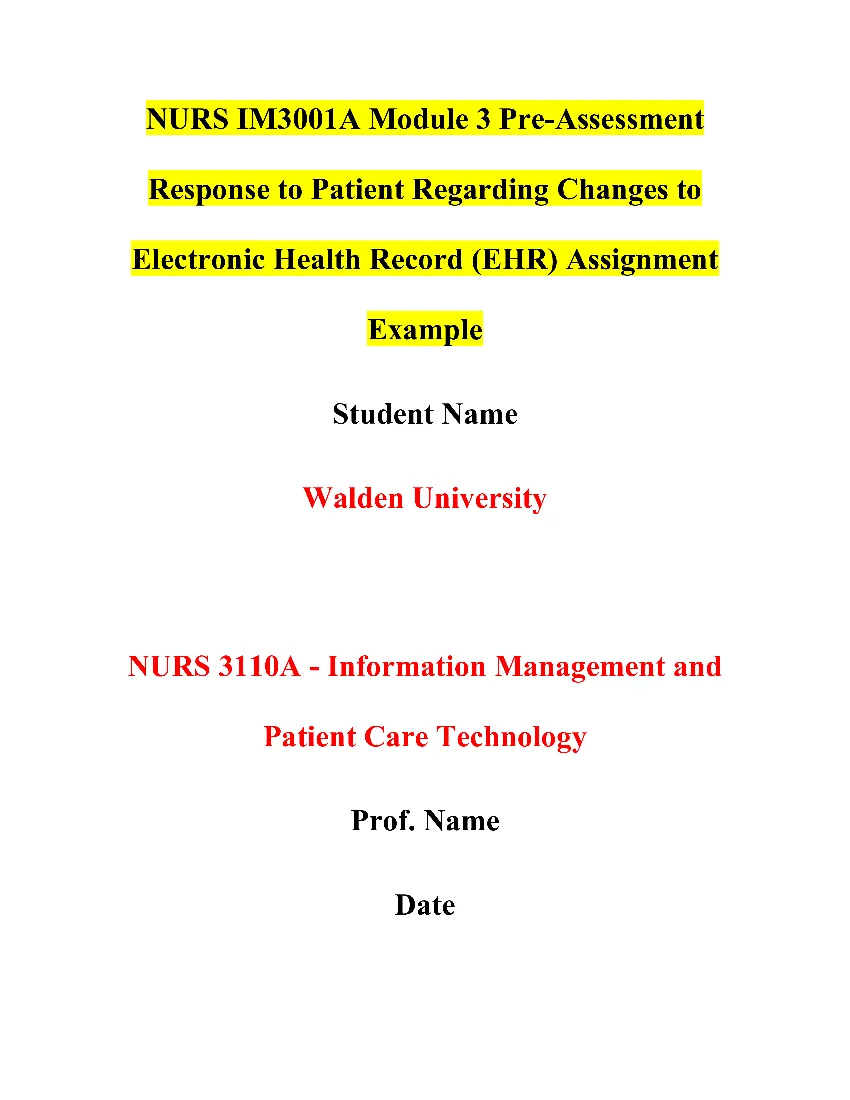 NURS IM3001A Module 3 Pre-Assessment Response to Patient Regarding Changes to Electronic Health Record (EHR) Assignment
NURS IM3001A Module 3 Pre-Assessment Response to Patient Regarding Changes to Electronic Health Record (EHR) Assignment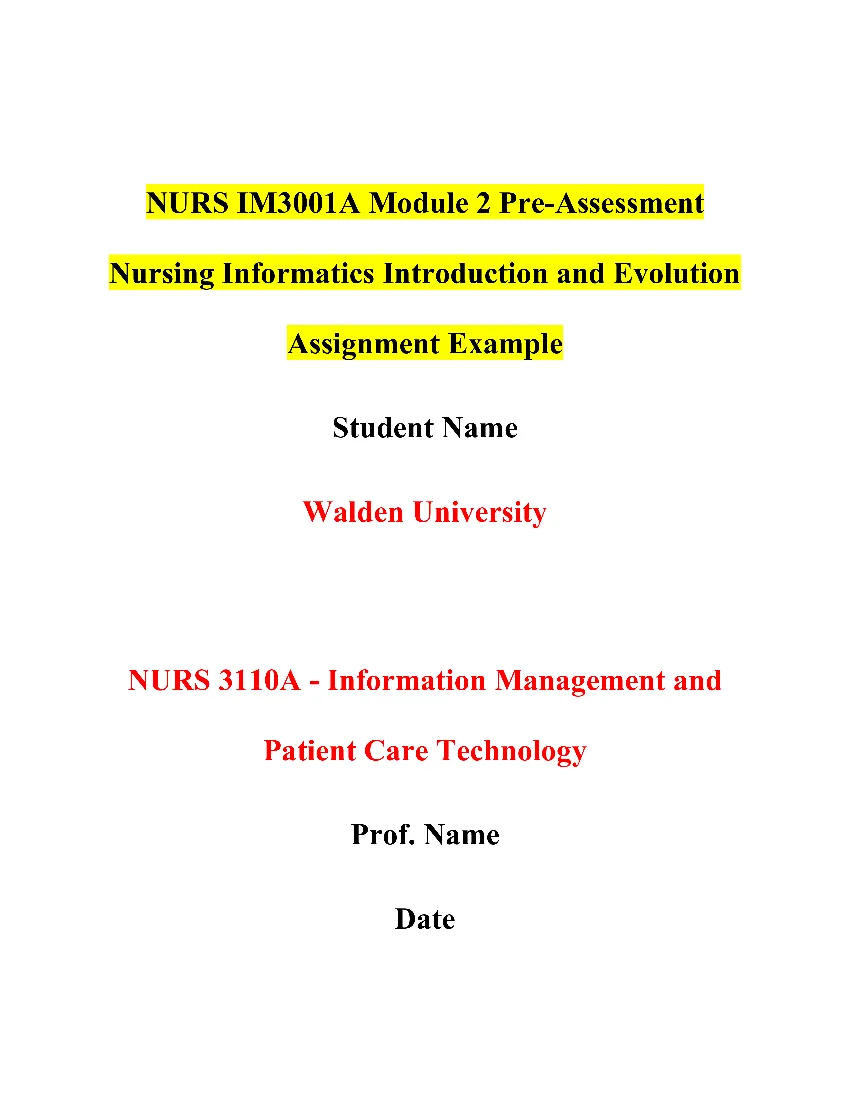 NURS IM3001A Module 2 Pre-Assessment Nursing Informatics Introduction and Evolution Assignment
NURS IM3001A Module 2 Pre-Assessment Nursing Informatics Introduction and Evolution Assignment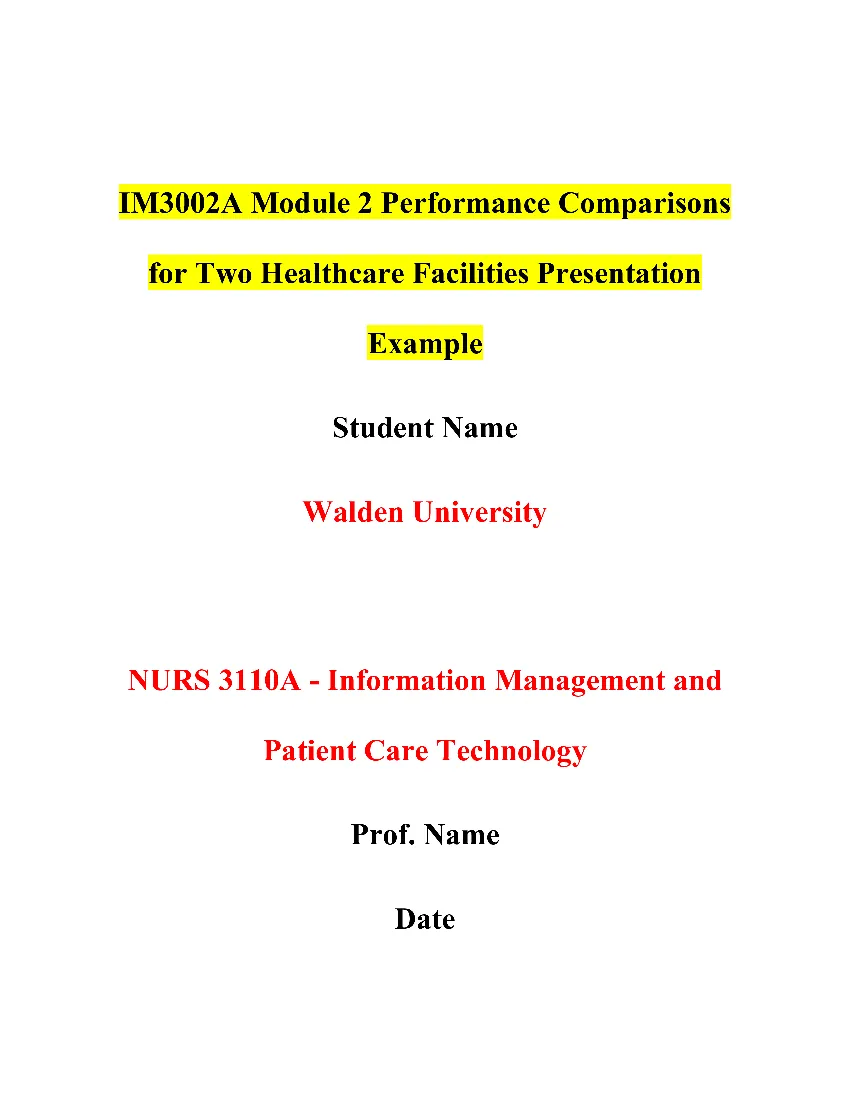 IM3002A Performance Comparisons for Two Healthcare Facilities Presentation Assignment
IM3002A Performance Comparisons for Two Healthcare Facilities Presentation Assignment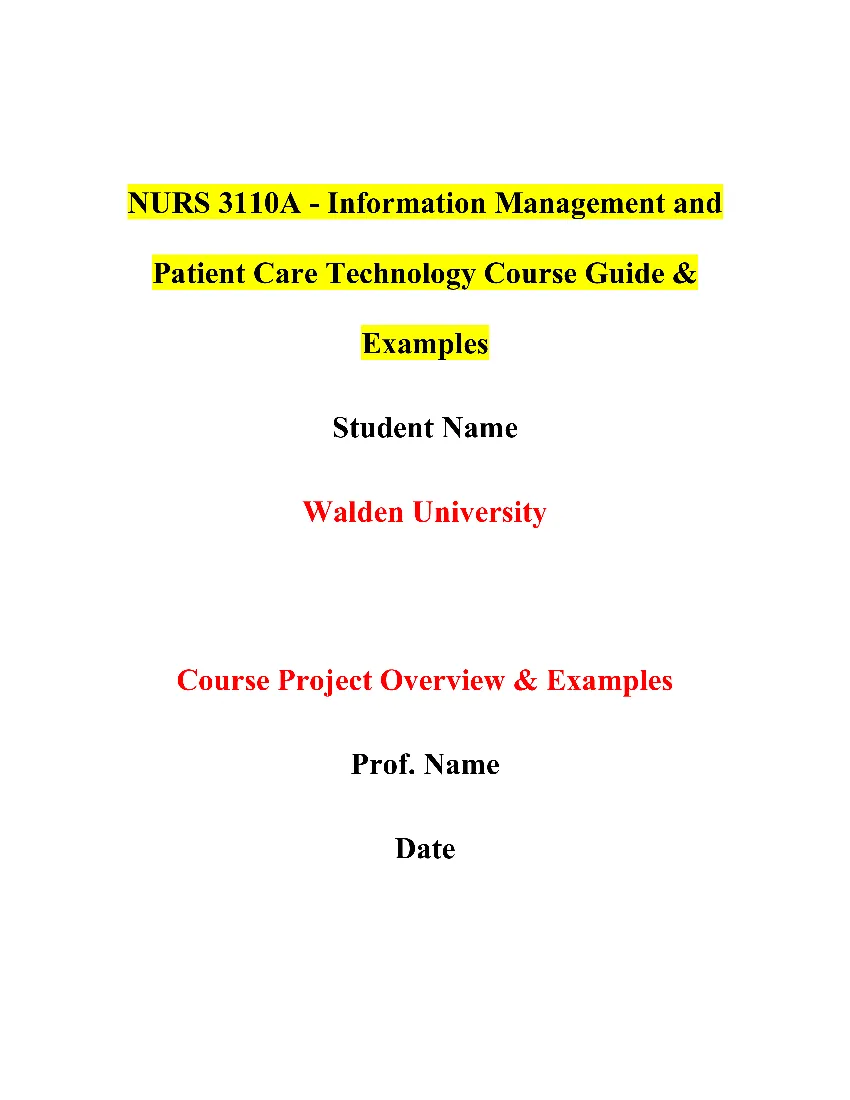 NURS 3110A – Information Management and Patient Care Technology Course Guide & Examples
NURS 3110A – Information Management and Patient Care Technology Course Guide & Examples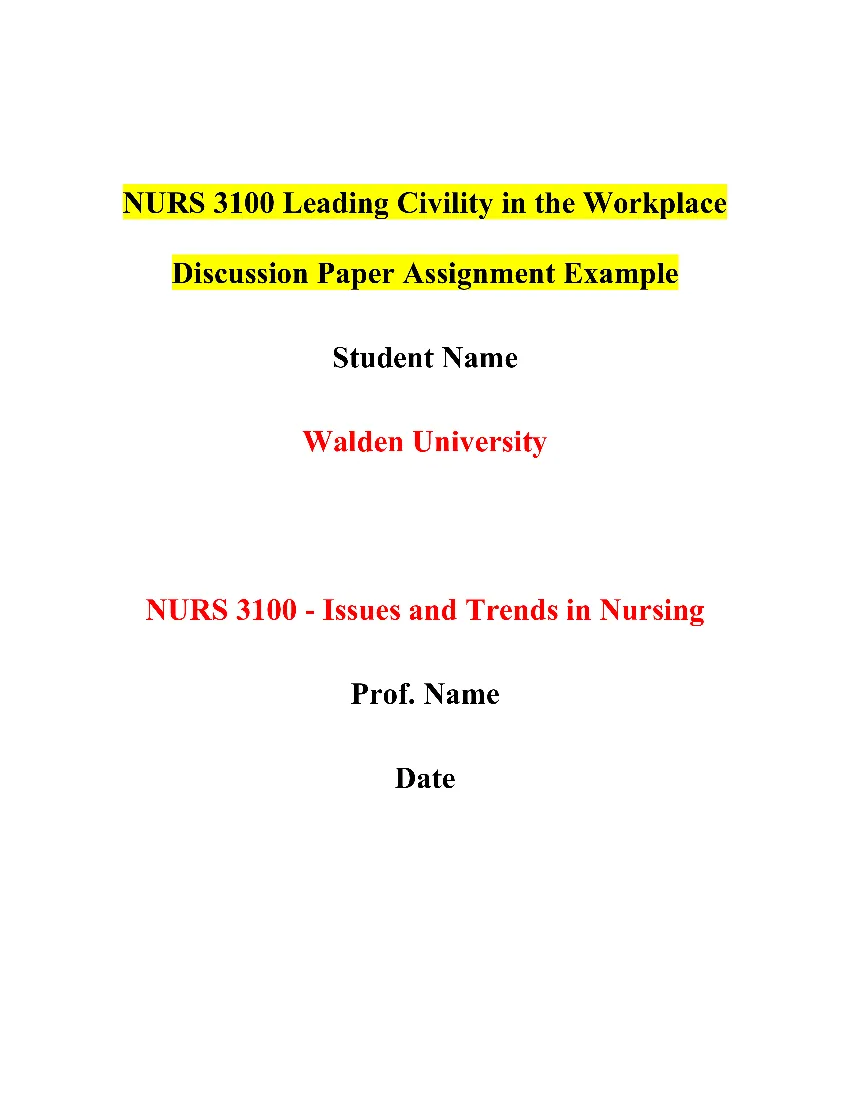 NURS 3100 Leading Civility in the Workplace Discussion Paper Assignment
NURS 3100 Leading Civility in the Workplace Discussion Paper Assignment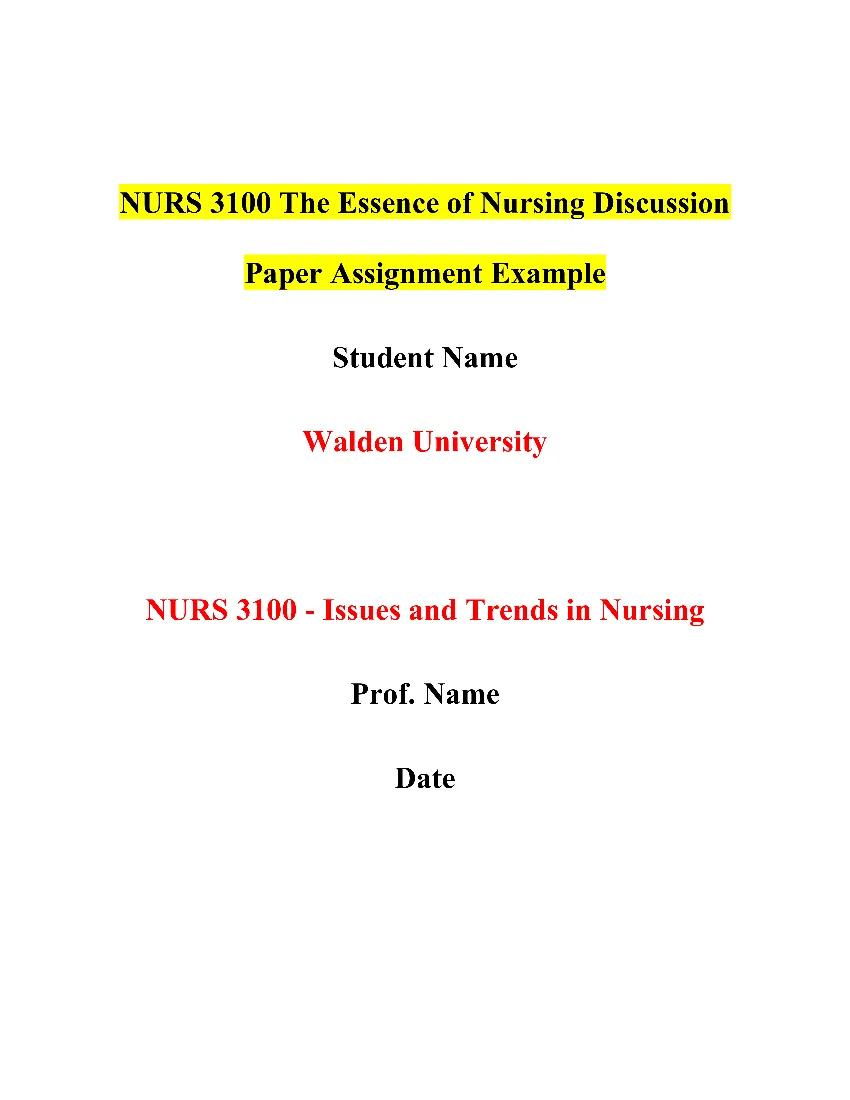 NURS 3100 The Essence of Nursing Discussion Paper Assignment
NURS 3100 The Essence of Nursing Discussion Paper Assignment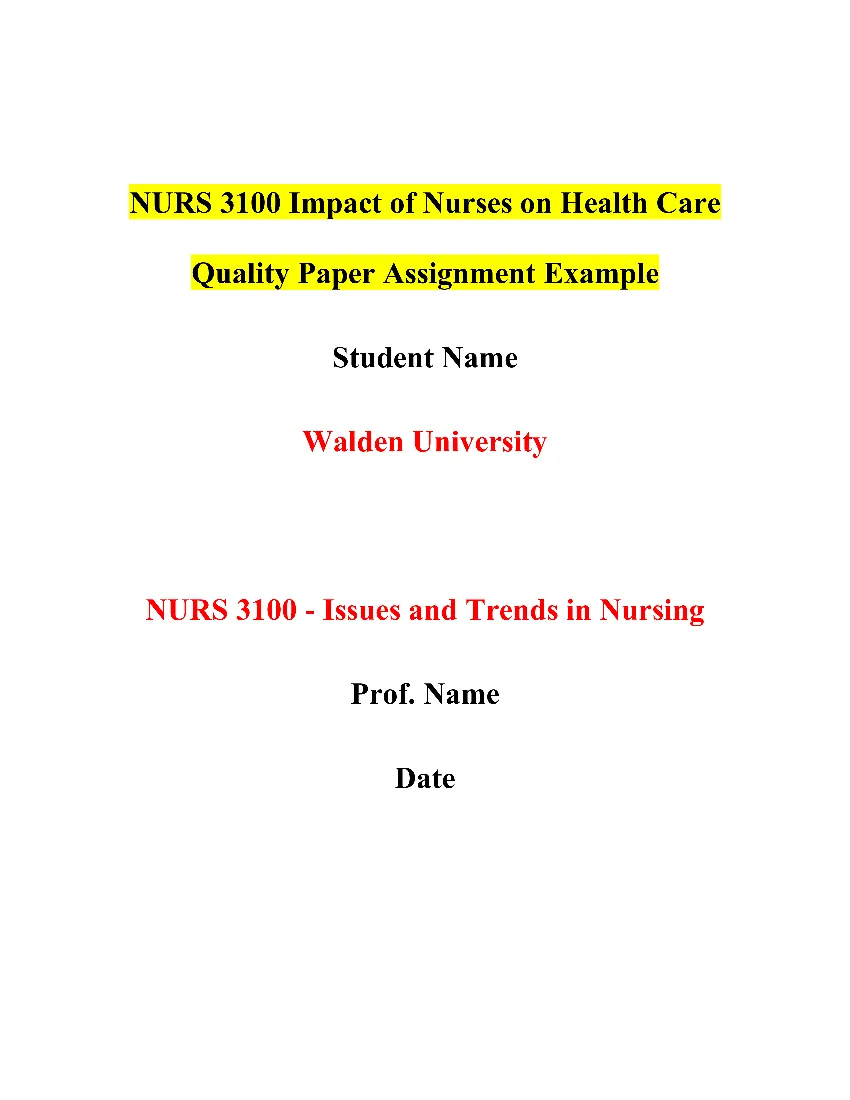 NURS 3100 Impact of Nurses on Health Care Quality Paper Assignment
NURS 3100 Impact of Nurses on Health Care Quality Paper Assignment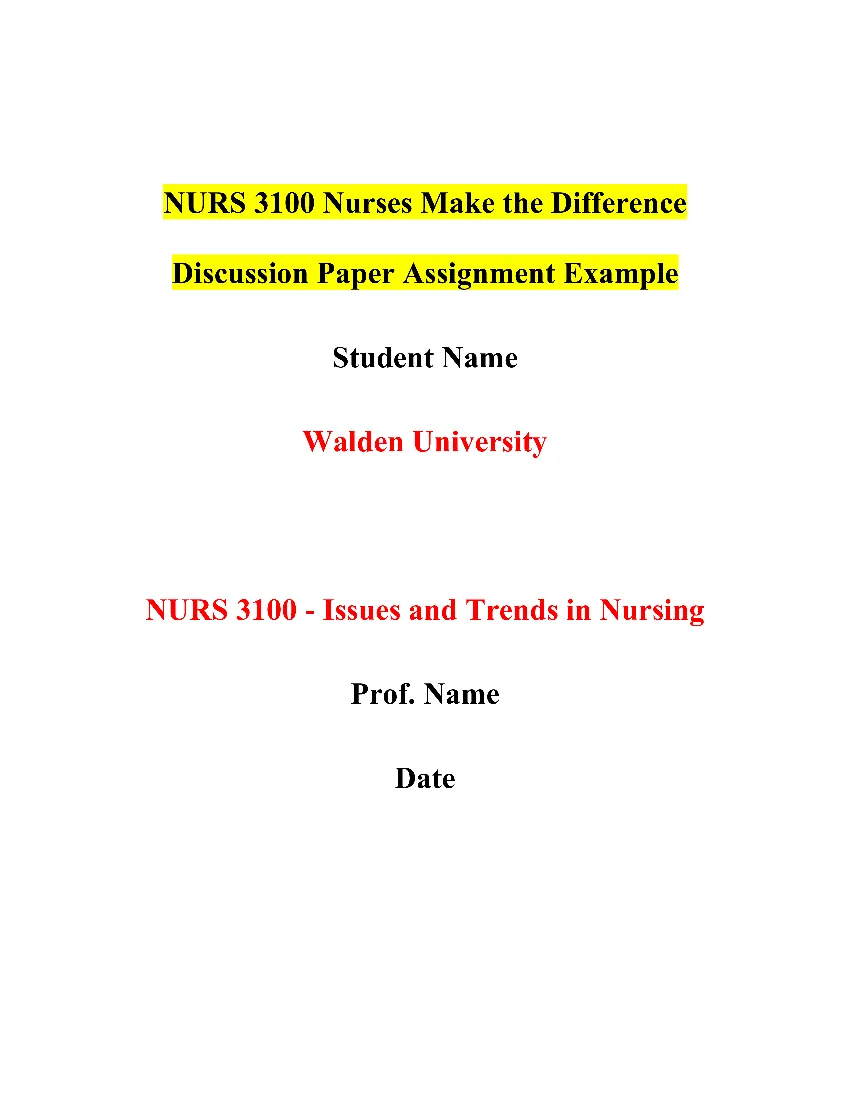 NURS 3100 Nurses Make the Difference Discussion Paper Assignment
NURS 3100 Nurses Make the Difference Discussion Paper Assignment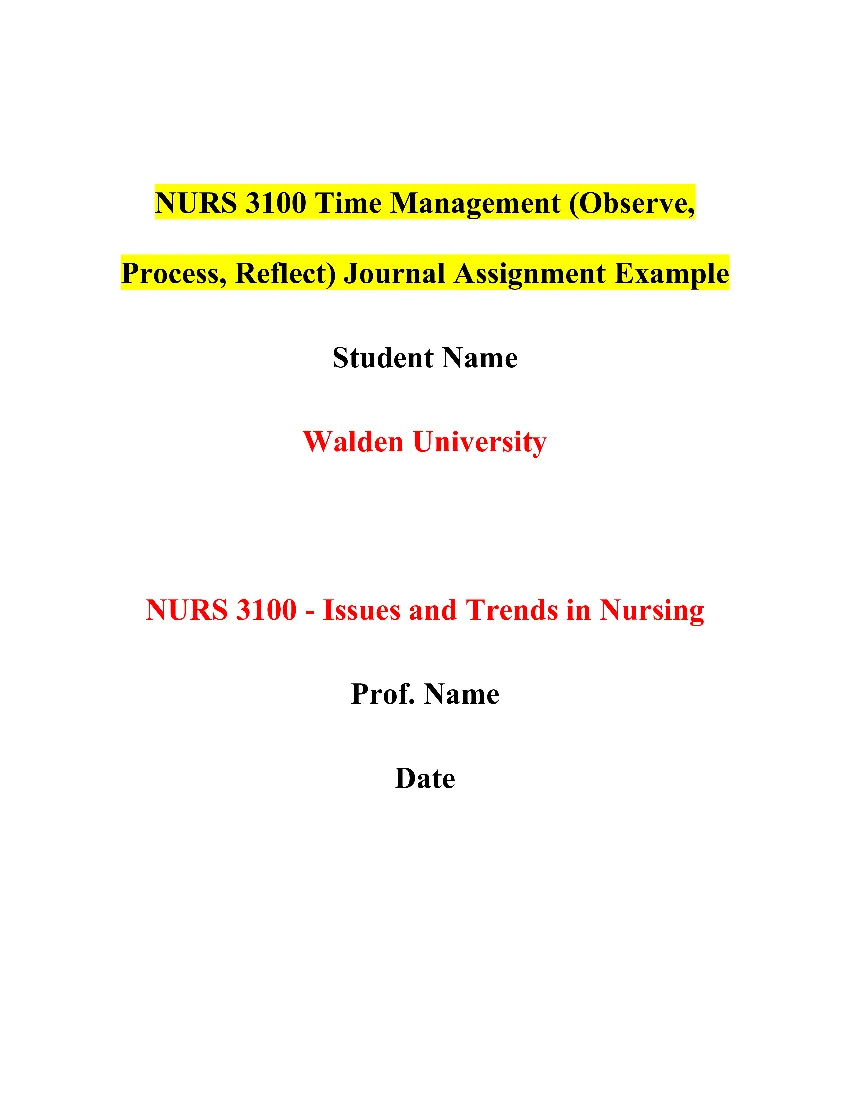 NURS 3100 Time Management (Observe, Process, Reflect) Journal Assignment
NURS 3100 Time Management (Observe, Process, Reflect) Journal Assignment